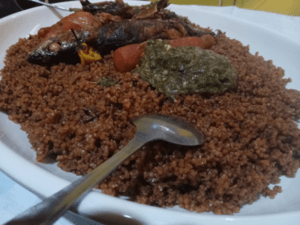
Recently, my phone rang, and there came a call from a lecturer at one of the public universities in Ghana. He wants to go to the Gambia to study Law and he is so optimistic about it. In our conversation, the Gambian delicacy, jollof sufficed and I told him how the bar school had had a toll on my immune system. However, what brought my energies back was the Gambian jollof Mao Ceesay’s wife made for me.
Mao Ceesay is a great colleague I met at the Gambia Law School in Banjul. He has a cooking wife. I am of the view that the qualities of a good cooking wife are not the same as those of a good partner. A good-cooking wife can cook, clean, do laundry, and take care of her family. She is like a ship on the river Gambia, and Mao Ceesay wanted me to feel her cooking prowess.
The Gambia Jollof
The issue of who has the best jollof has been the subject of debate for years, with Ghana and Nigeria always take centre-stage in this debate. So as a novice, I thought the best jollof comes from either Ghana or Nigeria. As a traveller, I tasted Nigerian jollof during my days in Ikorodu and Ilorin. In the case of Ghana, I have tasted different versions of jollof – funeral jollof, party jollof, streetside jollof and jollof made by my late grandma.
However, in recent times, The Gambia has come into the limelight as the country with the best jollof in some news publications.
Well, I was privileged to receive an invitation from Mao Ceesay after the bar exams. I think Mao invited me to have a taste of the Gambian version of jollof to cool off the pressure from the bar school before I left for Ghana. I honoured Mao’s invitation. I met his beautiful Gambian wife. They are a good couple and their chemistry and energies pierced me like ‘Elvis film’. Their union prompted me to start the search for a wife. She went to the kitchen at 1 p.m. As typical of men, we were in the hall watching some Ghanaian television channels.
I heard Mao’s wife pounding. I became more curious and when I enquired and was told she is pounding the ingredients together. I realised the recipes were all natural, including green hibiscus flower. As a natural health influencer and advocate for hibiscus tea, I got more interested.
The Gambian jollof is made from a combination of different local spices. One observation is that Gambians eat more local rice as compared to Ghanaians who eat more polished rice, which is often imported. It took her about 4 hours to get the jollof ready. The hibiscus and the carrots in the food served as an alternative to meat in the food.
The origin of jollof
As usual of me, I picked up my laptop to do some studies on this meal – ‘jollof’. I found that the origin of jollof rice itself emanate from the Senegambian region that was ruled by the Wolof or Jolof Empire in the 14th century, spanning parts of today’s Senegal, the Gambia, and Mauritania, where rice is grown. If that is the case, how come Ghana and Nigeria are claiming ownership?
In fact, the right name in the Gambia is “Benachin” which is the Wolof word for “one-pot” after the traditional practice of cooking all its ingredients in one pot. So I now understand the concept of why Mao’s wife pounded all the ingredients together in one pot!
No wonder this debate was settled on December 15, 2021, when the Senegalese version of this one-pot dish called ceebu jën (Wolof) or thiéboudiène (French) was included in the list of United Nations Educational, Scientific and Cultural Organisation (UNESCO), Intangible Cultural Heritage of Humanity. With this listing, the dish will have better protection and be more known abroad.
Although Jollof rice may be a delicacy in most of other West African countries, its real home is in the Senegambia region. This is why there have been tumult (after UNESCO declared Senegal as home to the rice-and-fish-based dish.
More than a regular meal
After tasting the Gambian jollof, I found that this is more than just a normal meal as it is medicinal too. Traditionally, the Gambians like eating together in the same bowl even with their guests; therefore, Mao’s wife invited me to join them; which I obliged. As I ate with Mao Ceesay, he encouraged me to eat the green hibiscus to improve my health. The green hibiscus flower appeared slimy like okra and tasted fine. I was brimming with joy as I ate the specially prepared Gambian jollof.
On a normal day, I do not like eating rice. But this particular jollof was more than a meal (and like Oliver Twist, I asked for more). When I eat polished rice, I often see a rise in my sugar level. But this was not the case. I suggest Gambian researchers and nutritionists should conduct a study on the impact of Gambian jollof on diabetics. There could be some interesting revelations in it.
What I also found was that the recipes used in Gambian jollof could vary depending on who is preparing it. I say this because I happened to eat another Jollof at the Brikama College during a conference, but that looked and tasted differently. The local recipes Gambians use could be their culinary supremacy as compared to the Ghanaians and Nigerians.
Mao further explained that the quality of the ingredients — fish and vegetables — is determined by the importance of the event or the degree of affection one has for a guest. The recipe and techniques are traditionally passed down from mother to daughter.
At the Brikama College, I notice that the Gambian jollof is eaten with the hands, although spoons or forks are usually used in restaurants. The dish is also tied to specific cultural practices. For instance, I was told it is forbidden to sit with a raised knee, the bowl must be held with the left hand, and grains of rice must not drop while one is eating.
All the local spices and herbs used by Mao’s wife were purely natural and medicinal in making the jollof. I think she understood what Hippocrates said: “Let food be thy medicine, thy medicine shall be thy food”. Also, I am sure she read what was contained in Genesis 1:29: And God said, “Behold, I have given you every plant yielding seed that is on the face of all the earth, and every tree with seed in its fruit. You shall have them for food.
That night when I got home, I only went straight to bed and I forgot all the nitty gritty of the bar school and exam. The rest they say is history. I only envy Mao for such a wonderful wife. No wonder the Bible says he who finds a wife finds a good thing. I will say that he who finds a wife who can cook home-grown food finds a good thing. So I urge food lovers to try Gambia jollof. Keep the debate on.
>>>The writer is a Professor of Naturopathic Healthcare, a Medical Journalist, an author, and a science writer. E. mail: [email protected]. This article is taken from the book ‘Life in the Gambia – Perspective from a Professor and an Aspiring Barrister’ authored by the writer.










